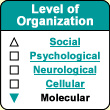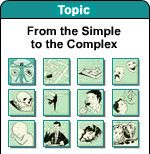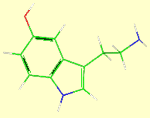A
presynaptic neuron has several specialized structures that distinguish it from
a postsynaptic neuron. The terminal button of the presynaptic neuron’s
axon contains mitochondria as well as microtubules
that transport the neurotransmitters from the cell body (where they are produced)
to the tip of the axon.  (click on 2. Axonal Transport)
(click on 2. Axonal Transport)
This terminal button also contains spherical
vesicles filled with neurotransmitters.
These neurotransmitters are secreted into the synaptic gap by a process called
exocytosis, in which the vesicles’ membranes fuse with that of the presynaptic
button. The synaptic gap that the neurotransmitters
have to cross is very narrow–on the order of 0.02 micron. Across the
gap, the neurotransmitters bind to membrane receptors: large
proteins anchored in the cell membrane of the post-synaptic neuron. At this location,
under an electron microscope, you can observe an accumulation of opaque material
which consists of the cluster of receptors and other signalling proteins that
are essential for chemical neurotransmission. | 










